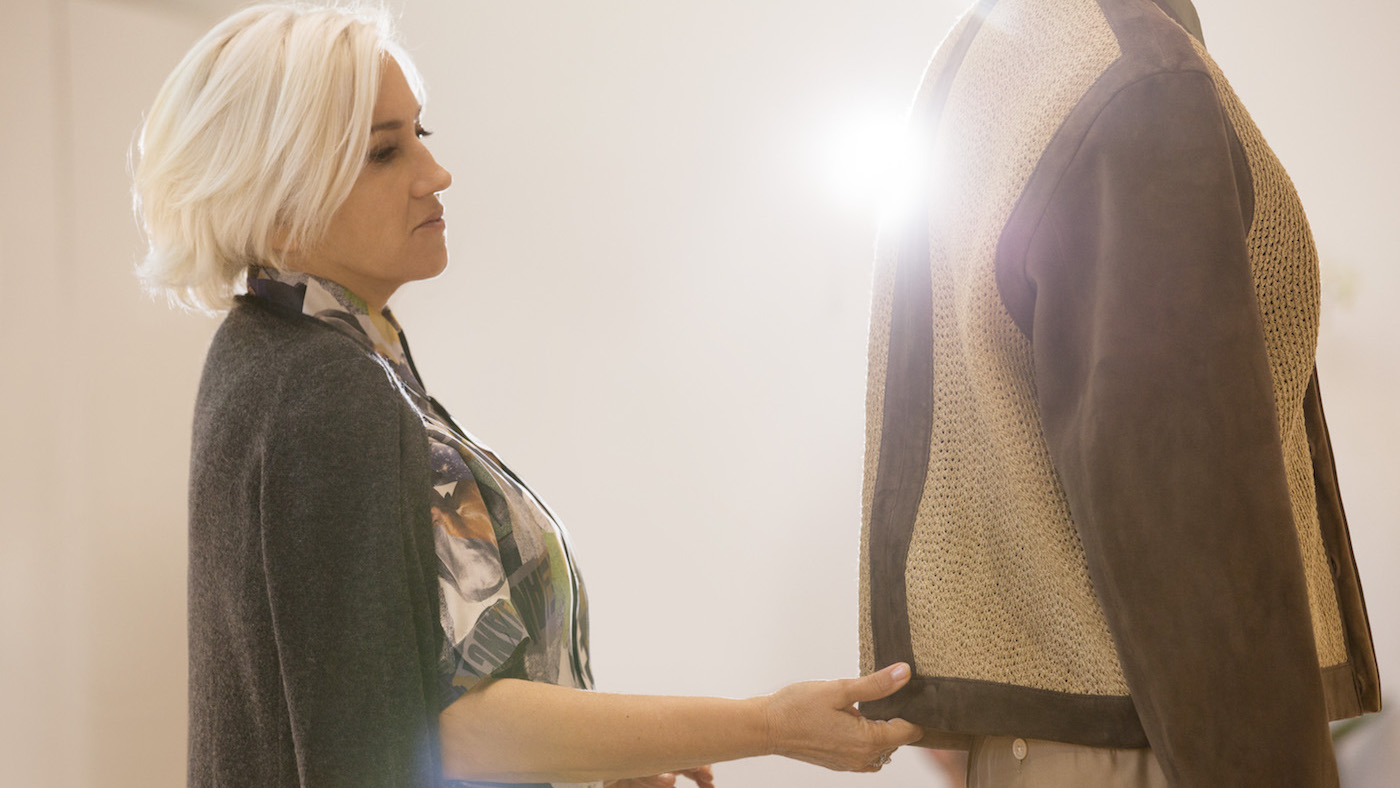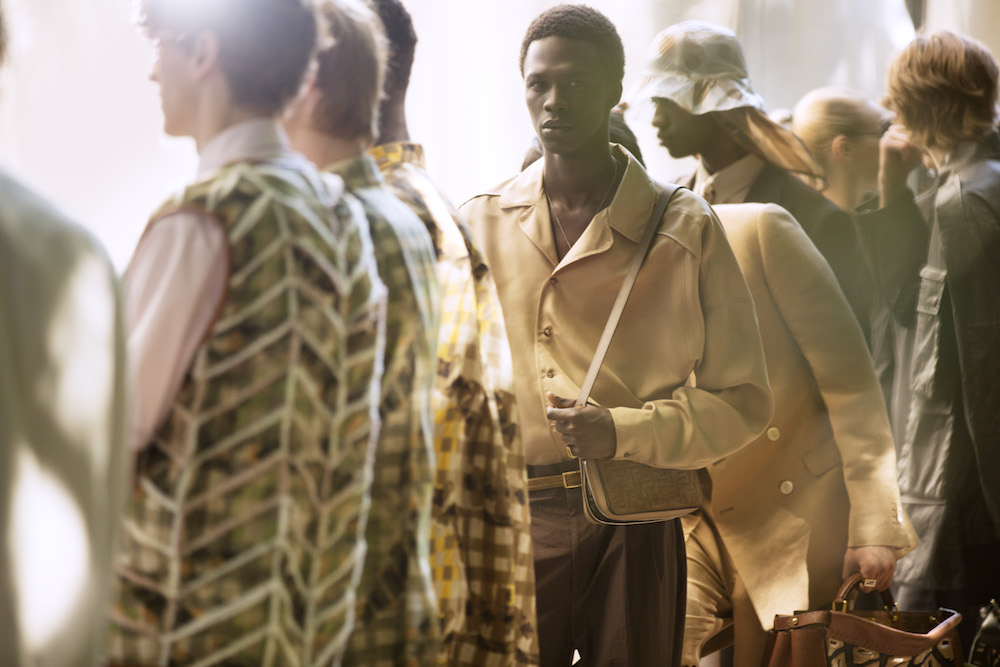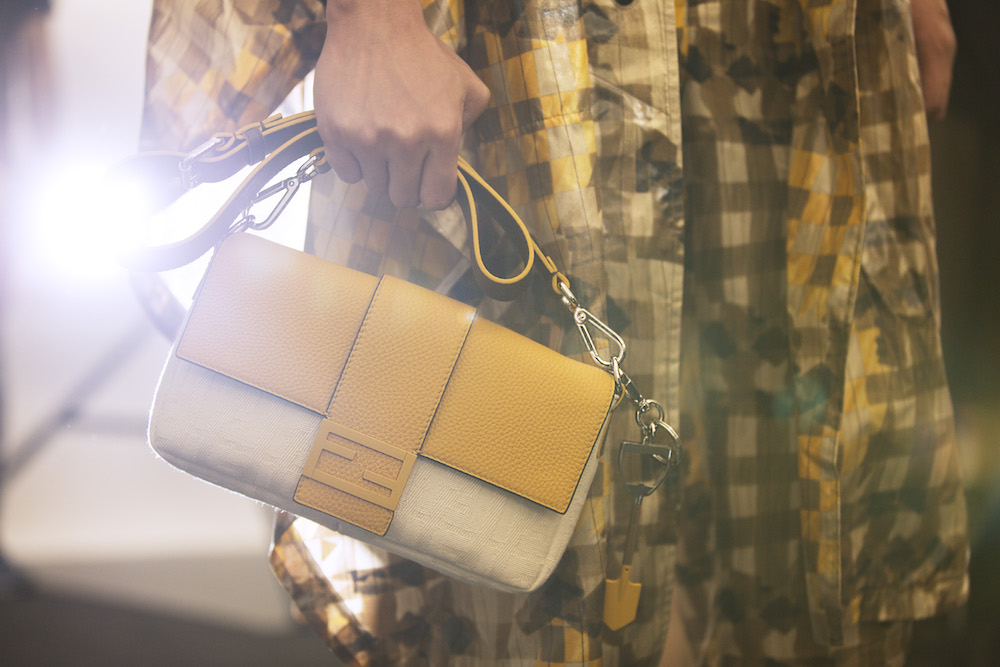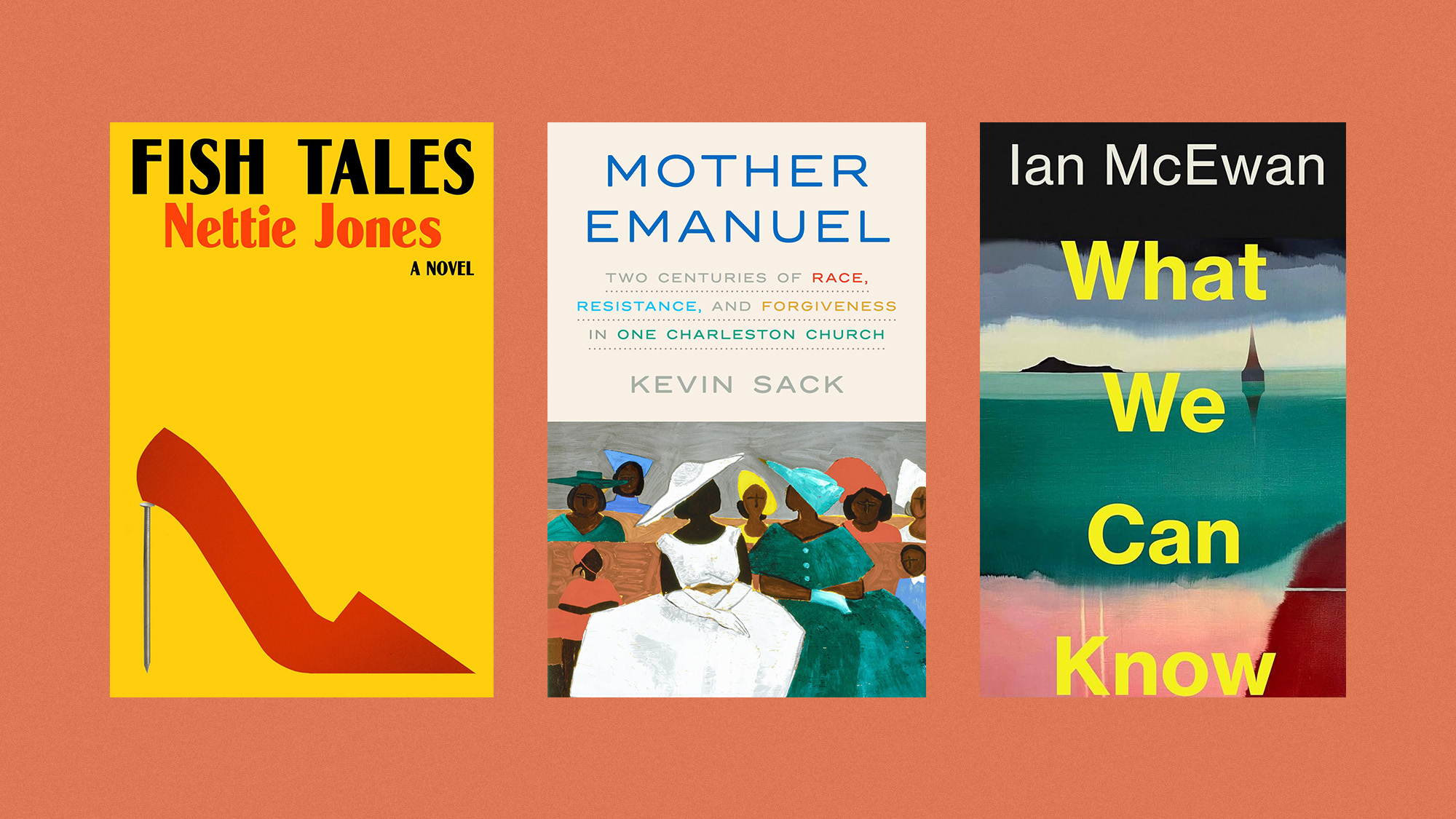Veni vidi Fendi: the all-conquering artistry of Silvia Venturini Fendi
An exclusive interview with the Fendi family scion

During an unexpected Roman downpour, an umbrella vendor made a surprising sale: to advertise his wares to potential customers visiting the Spanish Steps or the Sistine Chapel, he had fashioned a hat from a small umbrella. The makeshift accessory caught the eye of Silvia Venturini Fendi. “I asked to buy it and he laughed at me,” Venturini Fendi remembers. “He didn’t know that it would end up on a runway.”
Back at Fendi’s Roman headquarters – since 2015, the luxury brand has been operating from the cuboid Palazzo della Civiltà Italiana, which is clad in pale travertine marble and was originally commissioned by Benito Mussolini in the 1930s – the designer and her team recreated the headpiece in printed Fendi fabrics, including its emblematic Zucca, a repeat pattern of two inverse letter Fs, first sketched by Karl Lagerfeld in 1965.
Worn with tailored suits and shearling-collared blouson jackets, the headpiece’s simplicity of design set off Venturini Fendi’s menswear creations, which are exquisite and made from prestige materials. “I like to use simple codes and to give meaning to simple ideas. I like to not be pretentious in my references,” says Venturini Fendi, explaining her maxim. “I am a very practical person and I like to be connected to reality.”
The Week
Escape your echo chamber. Get the facts behind the news, plus analysis from multiple perspectives.

Sign up for The Week's Free Newsletters
From our morning news briefing to a weekly Good News Newsletter, get the best of The Week delivered directly to your inbox.
From our morning news briefing to a weekly Good News Newsletter, get the best of The Week delivered directly to your inbox.
Venturini Fendi was first charged with the brand’s menswear in 2000, following her triumphs as Fendi’s accessories designer. In 1997, she had dreamt up Fendi’s Baguette bag; a runaway success – to date, the marque has sold more than one million worldwide – the shoulder bag’s design married the delicate beauty of vintage evening bags with modern practicality.
It’s a game of contrasts that Venturini Fendi has since extended to her menswear collections. There have been winter coats cut like dressing robes (AW16), once-approved shirts and ties worn with shorts (SS18) and tongue-in-cheek mantras (‘Trust Fendi’, ‘Love’ and ‘Yes’ among them) printed on shirting and shearling jackets (AW17). “I like contrast,” she ponders. “I always say, ‘I don’t like no and I don’t like yes, I like maybe.’”
At Fendi, heritage is a matter of pride, but it never dictates, and creative whimsy is underpinned by artisanal excellence. “It is a company that is old – almost a hundred years – but very open,” Venturini Fendi says. “Open to rethink things.”
Adele and Edoardo Fendi established their eponymous business as a traditional pellicceria (furrier) specialising in furs, leathers and travel trunks on Rome’s central Via del Plebiscito in 1925. A second generation of Fendis took over in 1946, when Venturini Fendi’s mother Anna and her four sisters Paola, Franca, Carla and Alda inherited the family enterprise. In 1965, the five sisters hired Karl Lagerfeld as artistic director; Lagerfeld masterminded the launch of Fendi’s ready-to-wear line in 1977. The German designer continued his partnership with Fendi until his death in February 2019. “The flavour of Fendi is also about the people who have been here and who made it what it is today,” says Venturini Fendi, who is today the only family member to work with the LVMH-owned brand.
A free daily email with the biggest news stories of the day – and the best features from TheWeek.com

Lagerfeld’s five-decade-long tenure broke records, and Fendi has been a training ground for a class of designers who today helm the world’s biggest brands. This includes Italian designer Maria Grazia Chiuri, who joined maison Dior in 2016 as its first female artistic director. “I started at Fendi,” Chiuri says. “These unbelievable women gave me the opportunity to work in fashion.”
Chiuri’s fellow Fendi alumni include Valentino’s Pierpaolo Piccioli and Alessandro Michele, creative director of Gucci. For Venturini Fendi, this phenomenon can be attributed to the business’ culture of openness as rooted in its family history. “Here, this idea of sharing has always been very important. Before, it was Karl and the five sisters. There is a special alchemy that brings good luck to everyone, and we train well because there is a sense of [traditional] values mixed with experimentation. This is something that we learned from the Fendi family, the Fendi sisters, but also from Karl Lagerfeld.”
Today at the Palazzo della Civiltà Italiana, Venturini Fendi and her design team work from glass-fronted ateliers; ideas are shared constantly and freely. “It’s building a story, day by day,” says Venturini Fendi of working on collections that are sold in 200 standalone boutiques globally. “I have a team that understands; I am not doing all of this by myself. They know how to translate. I really believe that by yourself you don’t achieve anything.”
Venturini Fendi, who attended colleges in Rome and London’s Hampstead, got her own start working on Fendi’s international trunk shows, for which she travelled the world. “My family was very tough. You had to work or you had to study – and I hated the idea of studying.” She remembers big family get-togethers while growing up, during which films would be shown on a screen: “All the [Luchino] Visconti movies, like Il Gattopardo (The Leopard), and great classics, because it was my grandmother who chose them for us. Gone with the Wind, The Sound of Music... we were singing like crazy! All these big movies, but they were always very feminine, chosen for girls. I remember the few boys of my family were always so angry because there were never any action [movies]. It was always about looking at the costumes, the set, the music.” At Fendi, cinema has long been a passion: the brand’s creations can be spotted in films including Visconti’s 1974 Conversation Piece, Franco Zeffirelli’s La Traviata (1983) and Martin Scorsese’s The Age of Innocence (1993).
A sense of the cinematic underscores Venturini Fendi’s work to this day. “It’s like one scene in a movie,” she says of the brand’s Milan Fashion Week shows, which are scored to original soundtracks – mixed by the likes of producer Michel Gaubert and Alessandro Cortini, best known as the keyboard player of US band Nine Inch Nails – and unfold against purpose-built sets that have included a luggage conveyor belt (AW18 menswear) and, for Fendi’s AW16 couture collection, a transparent runway built across the Trevi Fountain. “I want to have fun,” says Venturini Fendi. “I want to feel the emotion, and I like to challenge myself.”

Venturini Fendi champions unexpected creative partnerships. Under her creative direction, the brand has invited artists John Booth, Sue Tilley and Nico Vascellari – the partner of Venturini Fendi’s daughter, the jewellery designer Del na Delettrez – to accentuate menswear collections. When opening a temporary Fendi Caffe at London department store Harrods last year, the brand drafted in artist Joshua Vides to imagine the space; nearby, the interiors of Fendi’s Sloane Street store have been dreamt up by Dimore Studio. Last winter’s Fendi menswear collection saw Venturini Fendi reimagine her emblematic Fendi and Peekaboo bags: in a team-up with Japanese nylon specialist Porter, the two bags made their debut as men’s accessories.
When mapping out this spring’s menswear collection, Venturini Fendi returned to her love for the cinema by confirming her “best friend”, the director Luca Guadagnino, as the season’s guest artist. The two first partnered in 2005 when authoring The First Sun, a short. lm starring Fendi’s SS06 menswear collection; Venturini Fendi has since earned IMDb credits as a producer of Guadagnino’s films, including I Am Love and Suspiria. “He has a very strong, good eye,” she says of Guadagnino. “He is such a visionary.”
When discussing Fendi’s SS20 menswear collection, the duo found common ground in their love of gardening. “We were talking about his new house in the country,” Venturini Fendi says. “I was telling him, ‘You will see [that] in the country you have so much work. It’s beautiful, but you have to be passionate [about it]. We talked about what he was going to grow in the country, and what I am growing. We shared experiences.”
Fendi’s SS20 collection was first presented in a show staged in the lush gardens of Milan’s 18th-century Villa Reale; their discussions of horticulture and the outdoors had given shape to workwear separates and loose summer tailoring rendered in natural materials (cottons, cashmeres and silks) and accessorised with floppy straw hats, logo-ed gardening gloves, and bags in the shape of watering cans. Elsewhere, Guadagnino contributed a new print. “I like gardening, but not only gardening – I like farming,” Venturini Fendi says, describing Casali del Pino, the family’s farm with 430 acres of grounds in northern Rome’s Parco di Veio. “I’m interested in those kind of things. That’s what I do at the weekend.”

For Venturini Fendi, any downtime is well deserved. In addition to orchestrating the brand’s menswear and accessory collections, since early 2019 she has been designing Fendi womenswear. Following in the footsteps of Karl Lagerfeld, Venturini Fendi presented her first solo creations for this spring season. “I think there is a dialogue between the two collections,” she says of working across both. Designing both men’s and womenswear for one house put Venturini Fendi in a unique position, and her collections have at times been a treatise on the traditional codes of masculine and feminine dressing. Her SS20 womenswear offering continues the gardening theme first set with her and Guadagnino’s masculine designs. There are dresses cut from chiffon printed with nostalgic oral motifs; bucket hats; and fabrications borrowed from outdoor clothing. “You can see that there is the same hand behind [them].”
Venturini Fendi’s most recent menswear show – for the AW20 season – marked a return to wardrobe classics, but with a Fendi twist: camel coats, suits in sombre tones and leather outerwear are paired with surprising accessories including leather versions of Fendi’s famous yellow boutique carrier bags. “This is the secret,” says Venturini Fendi of finding inspiration in the everyday. “I am curious and always awake, ready to find things that interest me.”
-
 Received a gift card this holiday season? Here’s how to maximize it.
Received a gift card this holiday season? Here’s how to maximize it.The Explainer Make the most of your present
-
 ‘Lumpy skin’ protests intensify across France as farmers fight cull
‘Lumpy skin’ protests intensify across France as farmers fight cullIN THE SPOTLIGHT A bovine outbreak coupled with ongoing governmental frustrations is causing major problems for French civil society
-
 The best books of 2025
The best books of 2025The Week Recommends A deep dive into the site of a mass shooting, a new release from the author of ‘Atonement’ and more